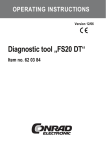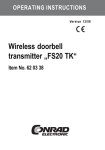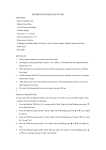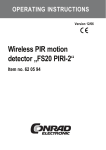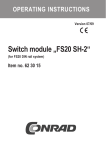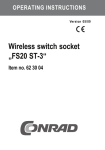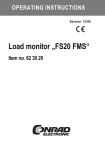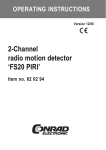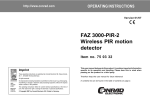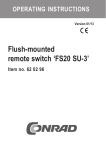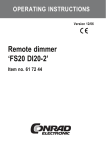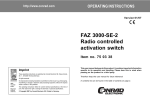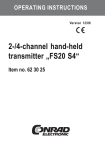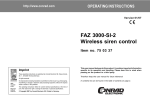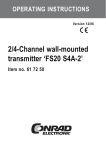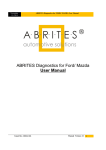Download Wireless humidistat „FS20 HGS“
Transcript
OPERATING INSTRUCTIONS Version 12/06 Wireless humidistat „FS20 HGS“ Item no. 62 03 47 Table of contents Page 1. 2. 3. 4. 5. 6 7. 8. 9. 10 11. 12. 13. 14. 15. 16. 17. 18. 19. 2 Introduction .................................................................................................................... 3 Prescribed use ............................................................................................................... 4 Scope of delivery ........................................................................................................... 4 Explanation of icons ...................................................................................................... 5 Safety instructions ......................................................................................................... 5 a) General information .................................................................................................. 5 b) Batteries and rechargeable batteries ...................................................................... 6 Features and functions .................................................................................................. 7 Preparing for installation and operation ........................................................................ 8 a) Selecting the installation location ............................................................................ 8 b) Mounting the wall holder .......................................................................................... 9 c) Inserting the batteries ............................................................................................... 9 Control panel ................................................................................................................ 10 Programming and operation ........................................................................................ 11 a) Switching the device on and off ............................................................................. 11 b) Setting the switching thresholds ............................................................................ 11 c) Switching commands ............................................................................................. 12 d) Connecting the FS20 receivers ............................................................................. 12 e) Manual operation .................................................................................................... 13 The FS20 address system .......................................................................................... 14 Integrating the ‘FS20 HGS’ into the address system ................................................. 16 a) Setting the house code .......................................................................................... 16 b) Setting the addresses ............................................................................................. 17 Setting addresses, beginning in normal mode ...................................................... 17 Setting a single address ......................................................................................... 17 Assigning function groups and master addresses ................................................ 17 c) Example of an address allocation .......................................................................... 19 Restoring the factory settings ...................................................................................... 21 Replacing the batteries ................................................................................................ 21 Information on the range ............................................................................................. 22 Handling ....................................................................................................................... 23 Maintenance and cleaning .......................................................................................... 23 Disposal ........................................................................................................................ 24 a) General information ................................................................................................ 24 b) Batteries and rechargeable batteries .................................................................... 24 Technical specifications ............................................................................................... 25 Declaration of conformity (DOC) ................................................................................. 25 1. Introduction Dear customer, Thank you for purchasing this product. This product meets the requirements of both current European and national guidelines. In order to preserve this condition and ensure the safe operation of the product we kindly ask you to carefully follow these operating instructions! Please read the operating instructions completely and observe the safety and operation notes before using the product! All company names and product names contained herein are trademarks of the respective owners. All rights reserved. Should you have any further questions, please contact our technical advisory service: Germany: Tel. no.: +49 9604 / 40 88 80 Fax. no.: +49 9604 / 40 88 48 e-mail: [email protected] Mon. to Thur. 8.00am to 4.30pm Fri. 8.00am to 2.00pm 3 2. Prescribed use The wireless humidistat ‘FS20 HGS’ is intended for recording room temperature and humidity in closed, indoor rooms protected from precipitation and to transmit switching signals wirelessly to FS20 switching modules. The device may not be taken apart, altered or modified in any way. Doing so not only invalidates the licence (CE) but also the guarantee/warrantee. Batteries must be used to power the device. Make sure that the product does not get damp or wet. Any use other than the one described above may damage the product and can also increase the risk of short-circuit, fire, electric shock, etc. All the safety instructions and installation notes in this manual must be observed without fail. 3. Scope of delivery • Wireless humidistat ‘FS20 HGS’ with wall holder • User manual 4 4. Explanation of icons The icon with a lightning flash in a triangle is used to alert you to potential personal injury hazards such as electric shock. The icon with an exclamation mark in a triangle points to important instructions in this user manual that must be observed. The ‘hand’ symbol provides special information and advice on operating the device. 5. Safety instructions The product’s guarantee becomes invalid, if the product is damaged as a result of the failure to observe these operating instructions! We do not assume any liability for any resulting damages! Nor do we assume liability for damage to property or personal injury caused by improper use or failure to observe the safety instructions. In such cases the product’s guarantee becomes invalid. Dear customer, the following safety instructions are intended to protect you as well as the device. Please take time to read through the following points: a) General information • Do not use this product in hospitals or medical institutions. Although the product emits only relatively weak radio signals, these may cause life-support systems to malfunction. This may also be the case in other areas. • For safety and licensing (CE) reasons any unauthorised alterations to and/or modification of the product are not permitted. Never take the product apart. • Make sure that the product does not get damp or wet. It is only suitable for installation and operation in indoor rooms, which are protected against precipitation (e.g., cellars, garages). 5 • This product is not a toy and should be kept out of the reach of children. The product contains small parts, glass parts (display) and batteries/rechargeable batteries. Install the product where it is out of the reach of children. • Do not leave packaging material lying around. This may become a dangerous plaything in the hands of children. • Handle the product with care; knocks, blows or even a fall from a low height can damage it. • If, during mounting, connection or installation you are not sure or have doubts about how to proceed, contact a skilled technician. b) Batteries and rechargeable batteries • Keep batteries/rechargeable batteries out of the reach of children. • Make sure that the polarity is correct when inserting the batteries/rechargeable batteries. • Do not leave batteries/rechargeable batteries lying around as they could be swallowed by children or pets. In such case seek immediate medical care. • Leaking or damaged batteries/rechargeable batteries may cause acid burns, if they come into contact with skin. Therefore, please make sure you use suitable protective gloves. • Make sure that batteries/rechargeable batteries are not short-circuited or thrown into a fire. They might explode! • Never disassemble batteries/rechargeable batteries! • Conventional batteries must not be recharged. They might explode! Only charge rechargeable batteries intended for that purpose and use suitable chargers. • If the device is not used for a longer period of time (when stored, for example), remove the inserted batteries/rechargeable batteries to prevent them from leaking and causing damage. The product may be powered using rechargeable batteries. However, due to their lower voltage (rechargeable battery = 1.2 V, battery = 1.5 V) and lower capacity, the period of operation and possibly also the range are reduced. Therefore, to ensure safe operation, please only use high-quality alkaline batteries (e.g., Conrad item no. 650117, mignon/AA). 6 6. Features and functions The ‘FS20 HGS’ measures the ambient temperature and humidity of its place of installation and wirelessly triggers any linked FS20 receiver components according to freely definable ambient humidity trigger levels. The system uses the 868 MHz ISM frequency band. Functions: • Separate settings for a minimum and maximum humidity value switching threshold. • Flexible allocation of power-on and power-off commands in accordance with the programmed humidity value switching thresholds (sends a power-on or power-off command to a FS20 receiver when humidity levels exceed or fall below the programmed target values). Function examples: A dehumidifier is switched on by a FS20 receiver, if the ambient humidity exceeds 70% or switched off, if the ambient humidity falls below 40%. A humidifier is switched on by a FS20 receiver, if the ambient humidity falls below 40% or switched off, if the ambient humidity exceeds 70%. • The receiver may be manually controlled using the ‘FS20 HGS’ • Can be installed practically anywhere, as power is supplied by batteries • Settings are saved in a nonvolatile memory (e.g., when batteries are changed) • Integrates into the FS20 address and coding system (ensuring reliable operation, no interference from neighbouring systems) 7 7. Preparing for installation and operation a) Selecting the installation location Depending on the specific function of the device, the installation location should be chosen to enable the exact (central) measuring of the temperature and ambient humidity. For this reason you should choose an installation location that has steady climatic conditions: • No draughts • No rising radiant heat (e.g., heaters) • No direct sunlight • No external influences due to a badly insulated outer wall When installing the device in a wet room (shower, bathroom, washroom, garage) you should mount it in a position where it cannot be reached by water jets or spray. The product is neither water-proof nor water-resistant. Further assembly instructions: • Install the device in an easily accessible location at eye-level (for easy operation and for reading the display) • Do not install the device on or in the immediate vicinity of large metal objects (this may reduce the range) • Do not install the device in refrigerators or other similar devices • Do not install the device near or on electrical/electronic products (this can reduce the range) 8 Before you install the device in a permanent position, check that the assigned receiver can receive switching commands from the ‘FS20 HGS’ in the predominant environmental conditions and at all times of day. b) Mounting the wall holder Caution! Ensure that there are no electrical cables, pipes or supporting elements in the wall at your chosen installation location. Damaging these can be dangerous or cause serious damage! 1. Remove the wall holder on the back of the device by sliding it downwards. 2. Hold the wall holder vertically against the wall at the installation location and screw it into place. p p Depending on your choice of installation location, you may need to drill holes first and use wall plugs. To do this, first mark the position on the wall through the holes in the holder. Remember, when choosing the installation position, that the ‘FS20 HGS’ slots into the wall holder from above and therefore make sure that there is enough room above the holder for it to slot in. c) Inserting the batteries • Remove the battery compartment cover on the rear of the device by pushing it downwards (follow the guide arrow on the battery compartment cover). • Insert two size AA batteries with correct polarity (observe plus/+ and minus/-) into the battery compartment. We recommend that you use high-quality alkaline batteries, (e.g., Conrad item number 650117). • Close the battery compartment. • Slot the device into the wall holder from above and push it down until it is held firmly by the wall holder. 9 8. Control panel 1 8 7 6 ìëðææ % êëðææ % èæðë 2 EIN °C 3 PROG 5 4 AUS 1 Scroller for data entry 2 On button ‘EIN’ 3 Programming button ‘PROG’ 4 Off button ‘AUS’ 5 Empty battery display 6 Display showing the current threshold value for the next switching command, here it is set to trigger at a value below 45% 7 Display of current ambient humidity 8 Display of room temperature 10 9. Programming and operation If there is a protective film over the display, please remove it now. a) Switching the device on and off • Switch the device on using the ‘EIN’ button. The device carries out a self-test, briefly displaying all the display segments. Then the version number appears, followed by the normal operation display. • The device is switched off using the ‘AUS’ button. All saved data are retained when the device is switched off and are available when the device is switched back on. b) Setting the switching thresholds 1. Press the ‘PROG’ button for approx. three seconds, until the ambient humidity values on the left side of the display are replaced by the set threshold value limits. Do not press the button for too long, as otherwise this will retrieve the house code setting. 2. Use the scroller to set the maximum threshold value. 3. Then press the ‘PROG’ button briefly. 4. Use the scroller to set the minimum threshold value. 5. Then press the ‘PROG’ button briefly. 6. The display reverts to the normal display (for an example see the figure in section 8). The figure in section 8 shows a current ambient humidity of 65% and that the next switching command will be sent when the value falls below 45%, as programmed (see d). A power-on or a power-off command is sent depending on whether the maximum threshold value (i.e., the value set in the upper line) is higher than the minimum one (e.g., maximum threshold value 70%, minimum threshold value 40%) or the other way around (e.g., maximum threshold value 40%, minimum threshold value 70%) . For more information on this, please see subsection 9. c). 11 c) Switching commands The ambient humidity at which a power-on or power-off command is sent depends on the maximum and minimum threshold values that have been programmed. For programming purposes (see section 9. b), the ‘maximum threshold value’ or ‘maximum switching threshold’ refers to the upper entry field (the first to be set during programming) and the ‘minimum threshold value’ or ‘minimum switching threshold’ refers to the lower entry field. • If you have set the upper switching threshold to a value higher than the lower switching threshold, a power-on command will always be sent when the ambient humidity exceeds the value of the upper switching threshold. A power-off command will be sent when the ambient humidity falls below the lower switching threshold. • This switching pattern is reversed, if you set a lower threshold value in the upper entry field than is set in the lower entry field. Now a power-off command is sent when the ambient humidity exceeds the lower switching threshold and a power-on command is sent when it falls below the upper switching threshold. d) Connecting the FS20 receivers 1. Set the FS20 receiver into programming mode following the instructions in the device’s user manual. 2. Then press the ‘PROG’ button briefly. A switching command with the current coding (factory setting) is sent to the receiver. 3. If the receiver responds, the device configuration is ready for operation. 12 Test the connection by repeatedly and briefly pressing the ‘PROG’ button on the ‘FS20 HGS’. The receiver’s switch status changes each time you press the button. e) Manual operation You can switch the receiver manually by briefly pressing the ‘PROG’ button on the ‘FS20 HGS’. The receiver’s switch status changes each time you press the button. At the same time the measurement data displayed by the ‘FS20 HGS’ is updated independently from the usual display interval. Please note: If the scroller or ‘PROG’ button are not used for longer than 60 seconds while data is entered, the device will switch back to the normal operating mode without saving the previously entered values. 13 10. The FS20 address system The FS20 address system is based on a house code, which allows several similar radio systems to be operated simultaneously. 256 different addresses can be set within a house code. These addresses divide into four address types with 225 individual addresses, 15 function group addresses, 15 local master addresses and a global master address. One address from each address type can be assigned to each receiver. This means that each receiver can respond to up to four different addresses, but only ever to one address per address type. If you need a receiver to respond to more than one transmitter, you can program the transmitters to the same address or, if different transmitter address types have been set, you can program the receiver consecutively to these different addresses. The individual address types have the following functions (this explanation applies globally to the entire FS20 system and not just to individual components): Single addresses Each receiver should be set to a single address so that it can be controlled separately. Function group addresses Several receivers are defined as a functional unit by being assigned to a function group address. If, for example, all the lamps in a house are assigned to a function group, then all the lamps in the entire house can be switched on or off by pressing one button. Local master addresses Several receivers are spatially defined as one unit and controlled via the local master address. If, for example, all the receivers in a room are each allocated to a local master address, then all you need to do is press one button when leaving the room to switch off all the consumer loads in the room. Global master address Several receivers are assigned to the global master address and are jointly controlled via this address. All the consumer loads can easily be switched off simply by pressing one single button when leaving a house, for example. This address system opens up a variety of possibilities. 14 You can even implement access authorisations by assigning three garage doors to different single addresses and a joint function group (‘garage doors’), for example. Several people can then each be given a hand-held transmitter with a relevant single address for one garage door, while all the garage doors can be opened via a hand-held transmitter with a programmed function group address or all the doors can be automatically closed in the evening via a FS20 timer. The various address types and addresses are only set on the transmitter and these settings are transmitted to the receivers via the address assignment. 15 11. Integrating the ‘FS20 HGS’ into the address system The house code, an address group and a subaddress are used for coding the transmitters and their individual buttons. You can also use special address group assignments to program the remote control, in this case the ‘FS20 HGS’, as a local or global master. The scroller, confirmed by the display, is used to enter the eight-digit house code, the two-digit address group and the two-digit subaddress. This addressing makes 225 single addresses, 15 function groups, 15 local master addresses and 1 global master address available within each house code to the ‘FS20 HGS’. a) Setting the house code Once the batteries have been inserted, the device sets a randomly selected house code. If required, this eight-digit house code can be changed as follows: 1. Keep the ‘PROG’ button pressed for approx. five seconds, until the ambient humidity values on the left side of the display are replaced by the house code. 2. Now set the first four house code positions, using the scroller. 3. Then press the ‘PROG’ button briefly. 4. Now set the next four house code positions, using the scroller. 5. To leave the setup mode, briefly press the ‘PROG’ button twice. You can now transmit the house code to the receiver, following the instructions in 9. d), if only this is to be changed. or To switch to the address setup, briefly press the ‘PROG’ button once (see the next section and continue immediately with ‘Setting a single address’). The display now only shows the four digits on the lower left. 16 b) Setting the addresses A channel’s address comprises a two-digit address group and a two-digit subaddress. The factory-set address group is ‘11’. If several transmitters are to be operated at the same time and control different receivers, then different addresses need to be set on the transmitters. Setting addresses, beginning in normal mode 1. Keep the ‘PROG’ button pressed for approx. five seconds, until the ambient humidity values on the left side of the display are replaced by the house code. 2. Then press the ‘PROG’ button twice. The display now only shows the four digits on the lower left. Now continue with ‘Setting a single address’. Setting a single address 1. Using the scroller, set the desired address. The first two digits refer to the address group, digits three and four refer to the subaddress. Example: 1431 (address group 14, sub-address 31) 2. When you have finished entering the address, press the ‘PROG’ button. The device returns to normal display. 3. Now transmit the code and address data to the receiver or receivers, following the instructions in section 9. d). Please note: The address group 44 and the subaddress 44 both have a particular meaning (see the following section). Assigning function groups and master addresses • Function groups (44xx) If you enter 44 as the address group, then the subaddress (provided this is not also set to 44; see the following section) is defined as a function group. 15 different function groups between 4411 and 4443 can then be defined. Possible are: 4411, 4412, 4413, 4414, 4421, 4422, 4423, 4424, 4431, 4432, 4433, 4434, 4441, 4442, 4443 17 • Local master (xx44) If you only set the subaddress to 44, then this channel functions as a local master within the set address group. All receivers that are programmed with this local master address are controlled simultaneously. Possible are: 1144, 1244, 1344, 1444, 2144, 2244, 2344, 2444, 3144, 3244, 3344, 3444, 4144, 4244, 4344 • Global master (4444) If you set the address group and subaddress of a channel to 44, then this channel functions as a global master. All receivers that are programmed with this global master address are controlled simultaneously. 18 The only global master is 4444. c) Example of an address allocation When you require a large, extended system it is advisable to select addresses systematically so that you have an overview of the addresses that have already been assigned and so that you can jointly control the programmed receivers simply and meaningfully in groups. House code, e.g. 1234 1234 Global master address 4444 Function group 44xx, e.g. 4411 ceiling lamps A Local master address, e.g. 1144 D 112 2 114 4 444 4 113 1 114 4 444 4 B 121 1 111 1 114 4 441 1 444 4 121 2 441 1 444 4 141 2 444 4 141 1 441 1 444 4 C 131 1 441 1 444 4 In order to distribute the address areas evenly across the house, a different address group has been assigned to each room in the house: room A: 11, room B: 12, room C: 13, room D: 14. The awning has been allocated to the room next to it, room B. Altogether the following 15 address groups are possible: 11, 12, 13, 14, 21, 22, 23, 24, 31, 32, 33, 34, 41, 42, 43. 19 In order to be able to separately control each receiver, you need to program each receiver to a single address. A subaddress is also required in addition to the address group that is already selected . In total, the following 15 subaddresses are possible for each address group: 11, 12, 13, 14, 21, 22, 23, 24, 31, 32, 33, 34, 41, 42, 43 In the example the awning is programmed to the single address 1211, which is comprised of the address group 12 and its subaddress 11. All the receivers in room A have also been programmed to a local master address. For the local master address 44 is always set as the subaddress, while one of the 15 local master addresses is selected via the address group. The range available for the address group is once again between 11 and 43 (11, 12, 13, 14, 21, 22, 23, 24, 31, 32, 33, 34, 41, 42, 43). In addition, all the lamps in the house can be controlled via the global master address 4444. The awning was not programmed to this address and can therefore only be controlled via its single address. The ceiling lamps in all the rooms are also combined in a function group and can therefore be jointly controlled. To select one of the 15 function groups, you need to set 44 as the address group and a value between 11 and 43 (11, 12, 13, 14, 21, 22, 23, 24, 31, 32, 33, 34, 41, 42, 43) as the subaddress. In the example the ceiling lamps have the function group address 4411. 20 12. Restoring the factory settings If you choose, you can restore the factory settings at any time. This will delete all the parameters that have been individually set. To do so, proceed as follows: 1. Keep the ‘PROG’ button pressed for longer than ten seconds. 2. Then release the button. If the ‘FS20 HGS’ was part of an FS20 wireless control system, none of the receivers will now respond to the ‘FS20 HGS’. All settings have now been deleted. The device must now be reprogrammed (house code, etc.). 13. Replacing the batteries When the battery-empty warning appears (see section 8) you should replace the batteries as soon as possible to ensure that the humidistat does not stop functioning. To change the batteries, follow the instructions in section 7. Your settings will be retained. Refer to the section headed ‘Disposal’ for information on how to dispose of your used batteries. 21 14. Information on the range Ranges and interference • The FS20 wireless control system (and therefore also the ‘FS20 HGS’) uses the 868 MHz range, which is also used by other radio services. Therefore devices that operate on the same or neighbouring frequency may restrict both its operation and its range. • The specified range of 100 m is the free-field range, which means the range within visual contact between the transmitter and receiver. In practice however, there are ceilings, walls, garages or adjoining buildings between the transmitter and the receiver that affect and reduce the range accordingly. A repeater is available to increase the range of the FS20 system. This forwards the radio commands it receives from the FS20, which results in a greater wireless range. • The actual attainable distance between the transmitter and receiver in normal operation depends very much on the installation location and the environment. As a rule – when mounted in a family home, for example – all components should operate faultlessly and experience no radio reception problems. Other causes of reduced ranges: • All types of high-frequency interference • Any buildings or vegetation • Conductive metal parts that are located near the devices or within or near their transmission path, e.g., radiators, metallised insulation glass windows, reinforced concrete ceilings etc. • Influence on the radiation pattern of antennas due to the distance from the transmitter or receiver to conductive surfaces or objects (also to human bodies or the ground) • Broadband interference in urban areas that reduces the signal-to-noise ratio; the signal is no longer recognised due to this ‘noise’ • Interference radiation resulting from insufficiently shielded electronic devices, for example, operating computers or similar 22 15. Handling Please observe all the safety instructions and information on installing and operating the device in this user manual. • The product is designed for use in closed, indoor rooms. It must not get damp or wet. • The product is not a toy and should be kept out of the reach of children. Do not install or operate the product within the reach of children; the product contains small parts which may be swallowed, glass parts (display) and batteries or rechargeable batteries. 16. Maintenance and cleaning The product requires no servicing except for battery replacement. Never open or take the product apart! Any repairs should be carried out by a skilled technician or professional workshop! Clean the product with a soft, clean, dry and lint-free cloth. To remove heavier dirt, use a cloth which is slightly moistened with lukewarm water. Do not use any solvent-based cleaning agents as these may damage the plastic casing (causing lettering to come off or discolouration). 23 17. Disposal a) General information Do not dispose of electric and electronic products via the household rubbish. When the product is no longer usable, dispose of it in accordance with the applicable statutory regulations. b) Batteries and rechargeable batteries As the consumer, you are legally obliged (regulation on the disposal of batteries) to return all your used batteries and rechargeable batteries. Do not dispose of your used batteries via the household rubbish! Batteries/rechargeable batteries containing harmful substances are marked with the following icons, which alert you to the fact that disposal via the household rubbish is prohibited. The identifiers for the respective heavy metals are: Cd=cadmium, Hg=mercury, Pb=lead (identifier is on the battery/rechargeable battery, for example, under the rubbish bin icons on the left). You can return your used batteries/rechargeable batteries free of charge to any authorised disposal station in your area, in our stores or in any other store where batteries/rechargeable batteries are sold. By doing so you comply with your legal obligations and also make a contribution to environmental protection. 24 18. Technical specifications • Frequency: ............................................. 868.35 MHz • Modulation: ............................................ AM, 100% • Wireless range: ...................................... 100m (free-field, see section 14) • Batteries: ................................................ 2 x AA batteries (LR06) • Battery life: ............................................. approx. 2 years • Ambient humidity range: ....................... 0.00% to 99.99% (non-condensing) • Ambient temperature: ............................ -9.9°C to +50°C • Reading frequency: ............................... 20 seconds 19. Declaration of conformity (DOC) We, Conrad Electronic, Klaus-Conrad-Straße 1, D-92240 Hirschau (Germany), hereby declare that this product complies with the fundamental requirements and other relevant regulations of directive 1999/5/EG. You can find the declaration of conformity for this product at www.conrad.com 25 26 27 http://www.conrad.com CONRAD IM INTERNET http://www.conrad.com Imprint These operating instructions are published by Conrad Electronic SE, Klaus-Conrad-Str. 1, D-92240 Hirschau/Germany. No reproduction (including translation) is permitted in whole or part e.g. photocopy, microfilming or storage in electronic data processing equipment, without the express written consent of the publisher. 100% recycling paper. Bleached without chlorine. The operating instructions reflect the current technical specifications at time of print.We reserve the right to change the technical or physical specifications. © Copyright 2006 by Conrad Electronic SE. Printed in Germany.




























